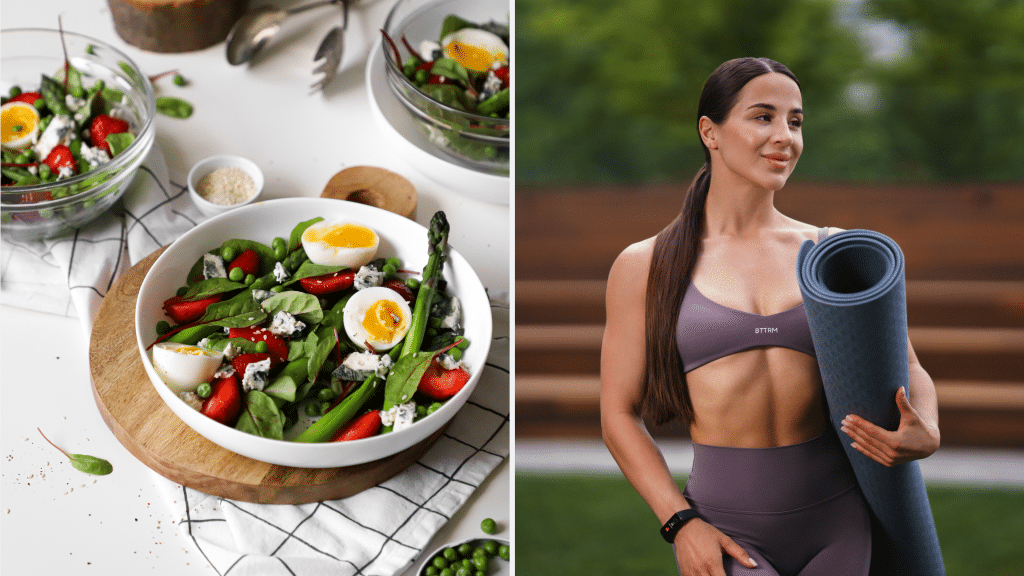You’ve heard it all when it comes to weight loss, from fad diets that work for a while but then fail miserably to exercise routines that are too hard on your joints and tendons. But what if you could lose two pounds a week without starving yourself? It sounds impossible, but it’s not! All it takes is some knowledge about how the body really works.
Is It Realistic to Lose 2 Pounds a Week?
Losing 2 pounds a week is generally considered a realistic and healthy goal for many people (1). This rate of weight loss is often recommended by health professionals as it typically involves creating a calorie deficit through a combination of diet and exercise.
However, individual results can vary based on factors such as starting weight, metabolism, diet, and physical activity levels. It’s always a good idea to consult a healthcare provider before you start any weight loss plan to ensure it’s appropriate for your personal health needs.
Is Losing 2 Pounds Noticeable?
Losing 2 pounds may not seem like a significant amount of weight, but it can definitely be noticeable both physically and mentally.
While the physical changes may not immediately be visible to others, you may notice a difference in the fit of your clothes or how you feel in your body. You may feel less bloated, and see your tummy becoming flatter.
Mentally, losing 2 pounds can be motivating and encouraging, particularly if you’ve struggled with weight loss in the past. It may also help boost your confidence and self-esteem as you start to see progress toward your goals.
How Many Calories Should I Eat to Lose 2lbs a Week?
To determine how many calories you should eat to lose 2 pounds a week, you’ll first need to know your total daily energy expenditure (TDEE), which is the number of calories you need to maintain your current weight. Once you have your TDEE, you can subtract 1,000 calories per day to achieve your desired weight loss (2).
Here’s a simplified way to estimate your TDEE:
- Calculate your Basal Metabolic Rate (BMR): This is the number of calories your body needs when at rest. You can use online calculators that require your age, gender, weight, and height.
- Factor in your activity level: Multiply your BMR by an activity factor (e.g. sedentary = 1.2, lightly active = 1.375, moderately active = 1.55, very active = 1.725, extra active = 1.9).
- Subtract 1,000 calories from your TDEE: This will give you the number of calories you should aim to consume daily in order to lose 2 pounds a week.
For example, if your TDEE is 2,500 calories, you would aim to eat 1,500 calories per day to achieve a 2-pound weekly weight loss. It’s important to ensure your calorie intake doesn’t drop too low as this can be unhealthy. Consulting a healthcare provider can help tailor this approach to your individual needs.
Creating a Calorie Deficit Is the Only Way to Lose Weight
The body maintains its weight by adjusting itself based on what goes into it – when you consume more calories than you burn, the body stores these extra calories to use later. The same concept applies when you consume fewer calories than used each day – stored fat is used as fuel instead of food.
When creating a calorie deficit, the ultimate goal is that it’s large enough to cause your current fat stores to be completely depleted. The required calorie deficit to lose 2 pounds a week is 7,000 calories. This translates to a calorie deficit of 1,000 kcal per day (3).
There are two ways to create a calorie deficit. You can either spend more time exercising or eat less. You can also do a mixture of these two strategies. Changing your habits so you’re eating less and moving more can be challenging, so here are some strategies you can try:
Change Your Way of Eating
Diet is the biggest struggle for people who are trying to lose weight. Try these tricks for lowering your calorie intake to lose 2 pounds a week.
- Be Wary of Fad Diets
Many people are frustrated by the dieting process. They want to enjoy a leaner body but get tired of using fad diets that don’t really work in the long term. The problem with most diets is they’re too restrictive.
Everyone should avoid starving themselves while dieting. This usually leads them to binge later on or overeat when they finally get a chance to compensate for their earlier deprivation.
If you’re trying to cut calories from your diet, don’t cut so much that your body is constantly craving food. You can lose 2 pounds a week following a diet plan with at least 1,200 calories per day (3). This will help your body burn calories faster even while resting – any less will slow down your metabolism, making it more difficult for you to lose weight.
If you wish to free yourself from all the extra pounds that have been weighing you down for way too long, start using the BetterMe: Health Coaching app and overhaul your entire life!
- Focus on Quality over Quantity
Instead of thinking “how much” or “how little” you’re allowed at each meal, you should focus on what it contains. Healthy foods contain plenty of nutrients that will help keep your body strong and hinder further weight gain, while unhealthy foods lack nutritional variety apart from fats or carbs.
You should avoid foods with a high level of unhealthy fats and sugars such as fried and packaged foods, refined sugar, candy bars, fast food, margarine, ice cream, etc. These foods tend to be highly processed and cause unhealthy spikes in blood glucose levels, followed by equally harmful crashes (4).
This pattern contributes to over-eating because one of your body’s natural reactions is to make you feel hungry once it gets used to the quick surges from certain types of food. If you want to eat more without gaining weight, try making better choices during each meal.
- Try Eating More Food to Lose Weight
It sounds counterproductive – how can eating more result in weight loss?
One solution many people have found is volume eating, which involves eating more food for each meal without upping your caloric intake. This allows you to consume enough calories while still enjoying an abundant and filling meal.
Volume eating involves eating more food at each meal but not increasing the total amount of calories you consume on a regular basis. It’s one of the most effective methods for creating a calorie deficit.
The idea behind volume eating is simple – you should eat a large amount of low-calorie, high-fiber foods, and other nutrient-rich foods at each meal instead of higher-calorie but less filling options such as junk food or sweets.
As this will fill you up with fewer calories, you can consume more at every meal and end up getting as much or more than someone who eats smaller portions but consumes the same number of total calories.
Volume eating works on many different levels:
First, by increasing the amount of food you eat at each meal, you can take advantage of a concept known as caloric density. This term refers to how much energy is packed into a certain amount of food.
A high-caloric density food such as olive oil has 100 calories in two tablespoons compared to the same number of calories from other foods such as ice cream or steak, which may have 50% more volume but only 50% more calories. Increasing the volume and decreasing the calorie content allows you to eat more.
Another crucial aspect is fiber.
Fiber fills you up without adding any additional calories and it helps slow down digestion so your body will feel full for longer (5).
The best part?
Fibers are abundant in many common fruits and vegetables, especially those with a high water content such as tomatoes, cucumbers, and lettuce. If you can eat plenty of these foods while keeping your calorie intake down, you’ll feel full with fewer calories!
Get More Active
Being physically active will help you achieve a calorie deficit without having to eat too few calories. Here’s how you can switch up your exercise routine and reach your target of calories to burn to lose 2 pounds a week.
Read more: How to Get Rid of Overnight Weight Gain? Discover 8 Easy Ways
- Strength Training
Strength training is a great way to lose weight for both men and women. Strength training burns calories by building lean muscle mass (6).
Lean muscle tissue relies on calories, even when you’re not active. This means that having more lean muscle will burn extra calories while you’re at rest. An interesting fact about strength training is that it creates an after-burn effect.
You see, we have something called EPOC (excess post-exercise oxygen consumption), which is what happens after you train. Your body works harder to recover from the workout, taking longer than regular exercise and requiring more energy (7).
Keep in mind that strength training isn’t just for men and women can benefit greatly from it as it creates a leaner physique with less body fat. Women can also often have difficulty building muscle due to hormonal balance. Although they may find gaining muscle challenging, they’ll notice that the more lean muscle mass they have, the more calories they burn.
You can focus on one area of strength training or do various exercises to include almost all your major muscles. For example, you could choose to do shoulder presses and push-ups for your upper body, lunges, and squats for your lower body.
The most important thing is consistency. You won’t see results if you don’t work out often and regularly. It’s best to do at least three strength training sessions per week, splitting up each session.
- Walk 10,000 Steps a Day
How can you lose 2 pounds a week by walking? Step up your daily walking by 10,000 steps. It may initially seem like a lot, but it’s not that difficult if you put in the effort every day and gradually work up to that point.
There’s no set time when people start counting their steps. A good time to walk is after work or school where you can take a stroll and enjoy nature as you walk. Or if your job involves a lot of walking, know that every step you take matters and should be factored into your daily activity levels.
There are several ways you can keep track of your daily step count. If you have the money, purchasing a step-counter watch would be ideal. It will count for you, so there will be no need to manually tally how many steps you’ve walked every day. In times when money matters, try using an app on your smartphone instead. It’s free and it does the job just fine. If you’re curious how many calories are burned in 10, 000 steps, check out our earlier article
Read more: I Want to Be Skinny: 6 Science-Backed Strategies for Fat Loss
Sample 7-Day Healthy Meal Plan for Weight Loss
To lose weight, you’ll need to create a calorie deficit in your dietary plans. However, you should also ensure you get all the nutrients your body needs such as macronutrients, vitamins, and minerals. Here’s how a healthy and effective 1,200-calorie meal plan can look:
Day One
Breakfast: 1 serving of 1 link sausage, 1 large egg, and cheese scramble – 21.8g fat, 8.9g carbs, 22.1g protein, and 322.6 calories.
Snack: 2 slices of cantaloupe served with nonfat Greek yogurt – 19.9g carbs, 1.2g fat, 25.7g protein, and 333 calories.
Lunch: 1 turkey sandwich alongside carrots with hummus – 49.6g carbs, 10.6g fat, 17.6g of protein, and 351 calories.
Dinner: 1 bowl of macaroni goulash – 53.8g carbs, 3.5g fat, 24.9g protein, and 332.5 calories.
Total daily calories: 1,195
Day Two
Breakfast: 2oz honey ham, 3 large scrambled eggs seasoned with 1 pinch of cayenne pepper and ¼ teaspoon of turmeric – 5.5g carbs, 16.2g fat, 29g protein, and 291.3 calories.
Snack: 1oz granola – 15.1g carbs, 6.8g fat, 4.2g protein, and 139 calories.
Lunch: 1 mango protein shake – 44.3g carbs, 6.1g fat, 32.8g protein, and 355.3 calories.
Dinner: 1 BLT sandwich served with easy hard-boiled eggs – 29.7g carbs, 21.5 fat, 25.2g protein, and 415 calories.
Total daily calories: 1,200
Day Three
Breakfast: 8oz breakfast fruit smoothie (½ cup halved strawberries, ½ medium banana, and ½ cup orange juice) and 4 rashers of bacon – 33.6g carbs, 19.7g fat, 8.1g protein, and 336 calories.
Snack: 2 servings of cinnamon apple bites – 43.2g carbs, 0.5g fat, 1g protein, and 161 calories.
Lunch: 1 serving of cucumber tomato salad with tuna, alongside 1 serving of cheese slices – 21.9g carbs, 12.1g fat, 43.5g protein, and 352 calories.
Dinner: 1 serving of shrimp and corn with basil – 32.7g carbs, 13.7g fat, 20.3g protein, and 315.1 calories.
Total daily calories: 1,163
BetterMe is your fast-track ticket to long-lasting weight loss! Tailor your fitness journey and maximize your results with just a couple of swipes!
Day Four
Breakfast: 2 oz pecans – 7.9g carbs, 40.8g fat, 5.2g protein, and 391.8 calories.
Snack: 8oz nonfat Greek yogurt alongside 1 cup of halved strawberries – 19.8g carbs, 1.3g fat, 24.1g protein, and 182.4 calories.
Lunch: 1 serving of lemon avocado salad – 20g carbs, 29,6g fat, 4.6g protein, and 333.9 calories.
Dinner: 1 bowl of macaroni goulash served with ½ can of tuna and corn – 53.8g carbs, 3.5g fat, 24.9g protein, and 332.5 calories.
Total daily calories: 1,241
Day Five
Breakfast: 2 medium apples – 50.3g carbs, 0.6g fat, 0.9g protein, and 189.3 calories.
Snack: 1 cup of nonfat Greek yogurt – 8.6g carbs, 0.9g fat, 24.5g protein, and 141.6 calories.
Lunch: 1 cup of nonfat Greek yogurt, 2 tablespoons peanut butter, and 1 tablespoon vanilla extract – 16.3g carbs, 17.4g fat, 31.5g protein, and 345.1 calories.
Dinner: 2 servings of chicken kabobs – 66.7g carbs, 7.4g fat, 56.5g protein, and 570 calories.
Total daily calories: 1,246
Day Six
Breakfast: 1 bowl of cornflakes and 1 medium apple – 60.4g carbs, 5.3g fat, 10.6g protein, and 317 calories.
Snack: 1oz granola – 15.1g carbs, 6.8g fat, 4.2g protein, and 138.6 calories.
Lunch: 1 serving tuna-stuffed pepper alongside 1oz almonds – 18.5g carbs, 17.0g fat, 41.1g protein, and 376 calories.
Dinner: 1 BLT sandwich – 29.3g carbs, 16.7g fat, 18.9g protein, and 343.3 calories.
Total daily calories: 1,175
Day Seven
Breakfast: 1 serving watermelon cooler smoothie and 2 medium apples – 80.1g carbs, 1.1g fat, 3.0g protein, and 306 calories.
Snack: 1 serving fruit salad made from 1 cup blueberries, and 1 cup halved strawberries – 33.1g carbs, 0.9g fat, 2.1g protein, and 133 calories.
Lunch: 2 servings of turkey lettuce roll ups with 2 dashes of pepper and 1oz almonds – 11.4g carbs, 16.8g fat, 24.3 protein, and 283 calories.
Dinner: 1 serving tomato mozzarella tuna melt – 31.6g carbs, 15.8g fat 51.1g protein, and 461.2 calories.
Total daily calories: 1,183
This 1,200-calorie diet meal plan is courtesy of eatthismuch.com.
Losing 20 pounds in 2 months is a challenging goal and may not be realistic or healthy for everyone. It would require losing an average of 2.5 pounds per week, which is above the generally recommended rate of 1-2 pounds per week for sustainable weight loss (1). Achieving this goal safely would require a significant calorie deficit, which may not be sustainable or healthy for every individual. It’s advisable to consult a healthcare professional to tailor a weight loss plan that meets your health needs while also ensuring nutritional balance. Losing 1 pound a day is generally not recommended as it would require a 3,500-calorie deficit per day, which is incredibly difficult to achieve in a healthy and sustainable manner. Such a deficit would typically require extreme calorie restriction and excessive physical activity, which can be dangerous and lead to nutritional deficiencies, muscle loss, and other health issues. A more sustainable approach is to aim to lose 1-2 pounds per week by adopting a balanced diet and regular exercise routine. Always seek the guidance of a healthcare provider before you attempt significant weight loss goals. Losing 3 pounds a week may be considered too fast for many people and could potentially be unhealthy, particularly if achieved through extreme calorie restriction or excessive exercise. The recommended weight loss rate is generally 1-2 pounds per week to ensure that the body isn’t deprived of essential nutrients and to minimize the risk of muscle loss. Rapid weight loss can also lead to other health issues such as gallstones and nutrient deficiencies. It’s best to aim for gradual, steady weight loss and seek professional advice to ensure a safe approach. The number of calories burned by walking 10,000 steps will vary depending on factors such as weight, pace, and walking surface. On average, a person who weighs 155 pounds may burn approximately 300-400 calories by walking 10,000 steps at a moderate pace (8). Heavier individuals may burn more calories, while lighter individuals may burn fewer. Using a fitness tracker can provide a more personalized estimate based on individual factors. Always consider combining walking with other forms of exercise and a balanced diet for optimal health and weight management.Frequently Asked Questions
Is losing 20 pounds in 2 months realistic?
How can I lose 1 pound a day?
Is losing 3 pounds a week healthy?
How many calories does 10,000 steps burn?
The Bottom Line
Losing weight can be quite simple once you understand the way your body works. The key is knowing how much you should be eating and what your body needs for you to get healthy.
If you’re looking for a way to lose weight, these excellent tips and tricks for reducing your caloric intake without feeling hungry or deprived of the foods you love can help. Don’t forget to be active and move more. By following these simple guidelines, you should be well on your way to losing 2 pounds per week.
DISCLAIMER:
This article is intended for general informational purposes only and does not serve to address individual circumstances. It is not a substitute for professional advice or help and should not be relied on for making any kind of decision-making. Any action taken as a direct or indirect result of the information in this article is entirely at your own risk and is your sole responsibility.
BetterMe, its content staff, and its medical advisors accept no responsibility for inaccuracies, errors, misstatements, inconsistencies, or omissions and specifically disclaim any liability, loss or risk, personal, professional or otherwise, which may be incurred as a consequence, directly or indirectly, of the use and/or application of any content.
You should always seek the advice of your physician or other qualified health provider with any questions you may have regarding a medical condition or your specific situation. Never disregard professional medical advice or delay seeking it because of BetterMe content. If you suspect or think you may have a medical emergency, call your doctor.
SOURCES:
- Key Recommendations (n.d., nih.gov)
- The association of change in physical activity and body weight in the regulation of total energy expenditure (2017, nature.com)
- Dietary intakes associated with successful weight loss and maintenance during the Weight Loss Maintenance Trial (2012, nih.gov)
- Optimal Diet Strategies for Weight Loss and Weight Loss Maintenance (2021, jomes.org)
- Fiber Intake Predicts Weight Loss and Dietary Adherence in Adults Consuming Calorie-Restricted Diets: The POUNDS Lost (Preventing Overweight Using Novel Dietary Strategies) Study (2019, nih.gov)
- Increasing muscle mass to improve metabolism (2014, nih.gov)
- Effects of exercise intensity and duration on the excess post-exercise oxygen consumption (2006, tandfonline.com)
- Calories burned in 30 minutes for people of three different weights (2021, harvard.edu)













